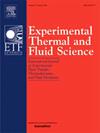动量比和韦伯数对横流射流液滴特性影响的实验研究
IF 3.3
2区 工程技术
Q2 ENGINEERING, MECHANICAL
Experimental Thermal and Fluid Science
Pub Date : 2025-08-27
DOI:10.1016/j.expthermflusci.2025.111599
引用次数: 0
摘要
在本研究中,研究了液体喷射和薄片喷射在横流中产生的液滴大小和速度分布。由于之前的研究对矩形喷嘴与圆形喷嘴相比的影响提供了有限的见解,因此本研究测试了四种不同的喷嘴——两种圆形喷嘴和两种矩形喷嘴——每种喷嘴具有不同的水力直径。本设计旨在探讨喷嘴几何形状和液压直径对液滴尺寸和速度分布的影响。为了评估液体和气体流动条件对液滴微观性质的影响,横流韦伯数范围为6 ~ 15,注射液韦伯数范围为90 ~ 1100。此外,在相对于喷嘴的不同距离和空间位置进行测量,捕捉所研究参数的三维空间分布。采用实验方法测量液滴的大小和速度。该测试装置具有高精度成像能力,并利用阴影成像技术对液滴进行可视化。采用协方差分析、多元线性回归和标准统计检验等数据分析方法对收集到的数据进行分析。流动条件对液滴尺寸影响的研究表明,注入流体与交叉流之间的动量比起着关键作用,动量比越大,液滴尺寸越小。此外,研究还确定了临界气体韦伯数和通用临界动量比,强调了交叉流动对液滴直径的双重影响机制。据作者所知,这一新颖的发现及其潜在的物理学原理在之前的研究中没有明确报道过。分析还表明,增加注入流体的韦伯数或增加交叉流的韦伯数都可以增加生成液滴的速度。在液滴大小和速度之间观察到一般的反比关系。在喷嘴效应方面,结果表明,矩形喷嘴产生的液滴较小,而较大的水力直径产生的液滴尺寸较大。最后,建立了幂律关系来描述液滴大小和速度随流动条件和每种喷嘴空间位置的分布。本文章由计算机程序翻译,如有差异,请以英文原文为准。
Experimental investigation of momentum ratio and Weber number influence on droplets’ characteristics for jet in cross-flow
In this study, the droplet size and velocity distributions resulting from liquid jet and sheet injections into a cross-flow were investigated. Since previous research has provided limited insights into the effects of rectangular nozzles compared to circular ones, this study tested four different nozzles – two circular and two rectangular – each with distinct hydraulic diameters. This design aimed to explore the influence of nozzle geometry and hydraulic diameter on droplet size and velocity distributions. To assess the effects of liquid and gas flow conditions on the microscopic properties of droplets, the cross-flow Weber number ranged from 6 to 15, while the injection fluid Weber number varied from 90 to 1100. Additionally, measurements were conducted at varying distances and spatial positions relative to the spray nozzle, capturing three-dimensional spatial distributions of the studied parameters. An experimental methodology was employed to measure droplet size and velocity. The test setup was equipped with high-precision imaging capabilities and the shadowgraphy technique was utilized for droplet visualization. The collected data were analyzed using data analysis approaches, including analysis of covariance, multiple linear regression, and standard statistical tests. The investigation into the effects of flow conditions on droplet size revealed that the momentum ratio between the injected fluid and the cross-flow plays a critical role, with higher momentum ratios resulting in smaller droplet sizes. Furthermore, the study identified a critical gas Weber number and a universal critical momentum ratio, highlighting a dual-effect mechanism of the cross-flow on droplet diameter. This novel finding and its underlying physics, to the authors’ knowledge, have not been explicitly reported in prior research. The analysis also demonstrated that increasing the Weber number of either the injected fluid or the cross-flow increases the velocity of the produced droplets. A general inverse relationship between droplet size and velocity was observed. Regarding nozzle effects, the results indicate that rectangular nozzles produce smaller droplets, while larger hydraulic diameters yield larger droplet sizes. Finally, power-law relationships were developed to describe the distributions of droplet size and velocity as functions of flow conditions and spatial position for each nozzle type.
求助全文
通过发布文献求助,成功后即可免费获取论文全文。
去求助
来源期刊

Experimental Thermal and Fluid Science
工程技术-工程:机械
CiteScore
6.70
自引率
3.10%
发文量
159
审稿时长
34 days
期刊介绍:
Experimental Thermal and Fluid Science provides a forum for research emphasizing experimental work that enhances fundamental understanding of heat transfer, thermodynamics, and fluid mechanics. In addition to the principal areas of research, the journal covers research results in related fields, including combined heat and mass transfer, flows with phase transition, micro- and nano-scale systems, multiphase flow, combustion, radiative transfer, porous media, cryogenics, turbulence, and novel experimental techniques.
 求助内容:
求助内容: 应助结果提醒方式:
应助结果提醒方式:


